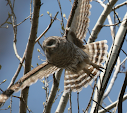
One of the great technological innovations that I have relied on heavily in my year and a half of birding is the CObirds mailing list for Colorado Birders. If you are a Coloradoan and are reading this you probably are already a member - if you are in a different locale I hope there is something similar for you to find in your own community. For me the mailing list is a teaser list of what to watch for in the area. Now that I am approaching my second spring migration I have a bit better feel for what to watch for, but reading about the observations of others definitely helps me prepare when I head out to a certain area.
The list also conspires to make a 'twitcher' out of all of us. The mailing list grew from the Colorado Rare Bird Alert, which as I understand it was once upon a time entirely phone based. While the scope of the mailing list has expanded, the rare bird alerts still make up the meat of the archive. I have certainly used the rarity alerts to help me plan day trips to different areas in Colorado, but often chasing a specific species at my skill level doesn't pan out. To save on gas, and to make sure that I am birding my favorite places rather than just chasing species, I limit myself to following only those alerts that are consistent over time, or are conveniently located to somewhere I need to be.

So, last night when I read that a Harris's Sparrow had been spotted in the Greenlee Preserve, (one of my regular lunch birding spots), I knew that I would have to swing back by for a visit to try my luck. I had two strong things going for me if the bird was still around; I had seen it before in Iowa, and I knew the Preserve well enough to have a good understanding of the area where it had been seen.

So, last night when I read that a Harris's Sparrow had been spotted in the Greenlee Preserve, (one of my regular lunch birding spots), I knew that I would have to swing back by for a visit to try my luck. I had two strong things going for me if the bird was still around; I had seen it before in Iowa, and I knew the Preserve well enough to have a good understanding of the area where it had been seen.
Of course birding at mid-day, with patchy snow cover, and trying to see into the underbrush where the Harris's Sparrow likes to forage is still a formidable challenge. When I did see the bird I had a good feeling that it was what I wanted, but with the glare I had to rely on a series of frames to really confirm the field marks I was seeing.

In the adult I had seen previously, the black crest, neck and bib were readily distinguishable from a distance and in poor light. This bird had already been distinguished as a first year when I saw it, and that accounts for the blotchy black areas where the darker feathers are just beginning to come in. Other key field marks that are visible on a Harris's Sparrow are, the light bill and legs, which distinguish them quickly at a distance from the also dark bibbed, but much more common House Sparrow. The Harris's sports a long tail for a sparrow, and has black streaks mixed in its brown back and on the sides of its whitish underparts. Throw on a pair of white wing-bars and a dark spot back behind the eye, and you have a youngster on the way to becoming one fine looking bird.


In the adult I had seen previously, the black crest, neck and bib were readily distinguishable from a distance and in poor light. This bird had already been distinguished as a first year when I saw it, and that accounts for the blotchy black areas where the darker feathers are just beginning to come in. Other key field marks that are visible on a Harris's Sparrow are, the light bill and legs, which distinguish them quickly at a distance from the also dark bibbed, but much more common House Sparrow. The Harris's sports a long tail for a sparrow, and has black streaks mixed in its brown back and on the sides of its whitish underparts. Throw on a pair of white wing-bars and a dark spot back behind the eye, and you have a youngster on the way to becoming one fine looking bird.

It certainly is satisfying to head out to a location in search of a specific individual bird, one that in my experience spends most of its time at the base of thick bushy shrubs, and actually locate it quickly enough to be able to return to work after a normal lunch break. I for one am hoping that it decides to stick around for a while, but more than likely it will pass on as just an early migrant.



No comments:
Post a Comment